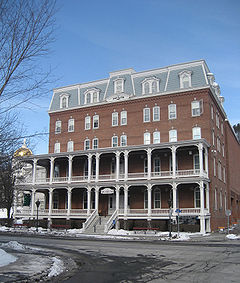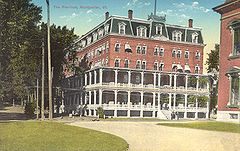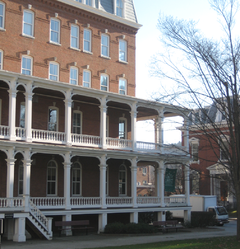
The Pavilion (government building)
Encyclopedia




Governor of Vermont
The Governor of Vermont is the governor of the U.S. state of Vermont. The governor is elected in even numbered years by direct voting for a term of two years; Vermont and bordering New Hampshire are the only states to hold gubernatorial elections every two years, instead of every four...
, located at 109 State Street in Montpelier
Montpelier, Vermont
Montpelier is a city in the U.S. state of Vermont that serves as the state capital and the shire town of Washington County. As the capital of Vermont, Montpelier is the site of the Vermont State House, seat of the legislative branch of Vermont government. The population was 7,855 at the 2010...
, capital of the U.S. state of Vermont
Vermont
Vermont is a state in the New England region of the northeastern United States of America. The state ranks 43rd in land area, , and 45th in total area. Its population according to the 2010 census, 630,337, is the second smallest in the country, larger only than Wyoming. It is the only New England...
. The building is built in the French Second Empire style, and houses the working offices, reception room, press briefing room, and living apartments of Vermont's governor. The term "The Fifth Floor" is sometimes used as a metonym for a governor's administration, or the Vermont governorship, which refers to the location of the governor's offices on the fifth floor of the Pavilion. The offices of two other elected statewide officials, the Vermont Attorney General
Vermont Attorney General
The Vermont Attorney General is one of five cabinet-level constitutional officers in the U.S. state of Vermont which are elected every two years. It was created by an act of the Vermont General Assembly in 1790, repealed in 1797, and revived in 1904. The office began as a one-person operation...
and the Vermont State Treasurer, are housed in the Pavilion along with the Agency of Administration and the Vermont Historical Society
Vermont Historical Society
The Vermont Historical Society was founded in 1838 to preserve and record the cultural history of the US state of Vermont. Headquartered in the old Spaulding School Building in Barre, the Vermont History Center is home to the Vermont Historical Society's administrative offices, the Leahy Library...
and its museum.
Operation as a hotel
The five story building is a 1971 reconstruction of an 1876 hotel, also called the Pavilion. While a hotel, the Pavilion was colloquially referred to as Vermont's "third house" (after the SenateVermont Senate
The Vermont Senate is the upper house of the Vermont General Assembly, the state legislature of the U.S. state of Vermont. The Senate consists of 30 members. Senate districting divides the 30 members into three single-member districts, six two-member districts, three three-member districts, and one...
and House of Representatives
Vermont House of Representatives
The Vermont House of Representatives is the lower house of the Vermont General Assembly, the state legislature of the U.S. state of Vermont. The House comprises 150 members. Vermont legislative districting divides representing districts into 66 single-member districts and 42 two-member...
) because it was so intertwined with Vermont's political history, and, while a hotel, served as a home for many of Vermont's legislators.
The first hotel on the site was a three-story building built in 1807–1808 by Thomas Davis. This building was designed by Sylvanus Baldwin, representative for Montpelier in the Vermont General Assembly
Vermont General Assembly
The Vermont General Assembly is the legislative body of the U.S. state of Vermont. The Legislature is formally known as the "General Assembly," but the style of "Legislature" is commonly used, including by the body itself...
and a self-taught architect-builder who also designed the first Vermont State House sited roughly on the site of the present Vermont Supreme Court. Shortly after construction Davis sold the hotel to Mahlon Cottrill who greatly enlarged the building, rebuilding it in the Greek Revival style. Cottrill established the name The Pavilion, and added piazzas on the south and west sides as in the present building. In 1874 Theron O. Bailey acquired the hotel, razed the second building and erected a new ninety-guestroom Pavilion, adding two full floors, and an attic floor below its fashionable new mansard roof
Mansard roof
A mansard or mansard roof is a four-sided gambrel-style hip roof characterized by two slopes on each of its sides with the lower slope at a steeper angle than the upper that is punctured by dormer windows. The roof creates an additional floor of habitable space, such as a garret...
. Steam powered elevators carried guests from the ground to fifth floor. Two new ball rooms, dining rooms, and lounges were added – all lit by gas jet. A large two-story Italianate style piazza was added on the south side facing State Street, and to the west facing the public lawn of the Vermont State House
Vermont State House
The Vermont State House, located in Montpelier, is the state capitol of Vermont and the seat of the Vermont General Assembly. The current Greek Revival structure is the third building on the same site to be used as the State House...
. Bailey's grand new hotel cost $100,000, and opened in time for the 1876 Centennial of American Independence.
For three-quarters of a century the Pavilion remained the grand hotel of Montpelier. An increase in legislators willing to commute, by car, from home to the state house, contributed to the hotel's steady decline. The hotel ceased operation in October 1966.
Reconstruction as a state office
The state of Vermont acquired the property in 1969. Restoration and reuse of the building was briefly considered, but a pressing need for expansion of state offices in the capital complex area, coupled with a lack of sensitivity for historic preservation, led to the complete razing of the building and the subsequent construction of a new Pavilion. The west and south exterior façades are academic copies of the original building, faithful except for the missing chimneys and cast-iron cresting along the mansard roof. A large two-story piazza wraps around the building's south and west sides as in the 1876 building. The entry foyer on State Street and an adjacent reception room recreate the building's original ornate French Second Empire style interiors complete with polychrome stencilling, period artwork, and furnishings.New working offices for the governorship
When the current building opened in 1971, Governor Dean DavisDeane C. Davis
Deane Chandler Davis was born in East Barre, Vermont. He was the 74th Governor of Vermont, from 1969 to 1973, and a delegate to the Republican National Convention in 1948....
had the offices of the governor located in the southeast corner of the fifth floor, approached from a long corridor then used as a gallery of Vermont artists. A modernist addition, in the form of a contemporary steel and glass wing was added to the building in the 1980s. This wing is to the northwest, directly north of the state library and Vermont Supreme Court
Vermont Supreme Court
The Vermont Supreme Court is the highest judicial authority of the U.S. state of Vermont and is one of seven state courts of Vermont.The Court consists of a chief justice and four associate justices; the Court mostly hears appeals of cases that have been decided by other courts...
. The working office of the governor was moved to this wing, providing the office with a dramatic view of the State House dome to the northwest. A ceremonial office for the governor is provided in the State House
Vermont State House
The Vermont State House, located in Montpelier, is the state capitol of Vermont and the seat of the Vermont General Assembly. The current Greek Revival structure is the third building on the same site to be used as the State House...
, and is used on a near daily basis during legislative sessions.
Living apartments
The state of Vermont previously maintained an official residence for Vermont's governors called the Chester Wright House at 159 State Street, a large late GeorgianGeorgian architecture
Georgian architecture is the name given in most English-speaking countries to the set of architectural styles current between 1720 and 1840. It is eponymous for the first four British monarchs of the House of Hanover—George I of Great Britain, George II of Great Britain, George III of the United...
style house built in 1809. The Greek Revival
Greek Revival architecture
The Greek Revival was an architectural movement of the late 18th and early 19th centuries, predominantly in Northern Europe and the United States. A product of Hellenism, it may be looked upon as the last phase in the development of Neoclassical architecture...
portico and terrace was added later in the nineteenth century. The family of Governor Joseph B. Johnson
Joseph B. Johnson
Joseph Blaine Johnson was an American politician who served as the 70th Governor of the state of Vermont....
were the last regular residents, leaving the house at the end of his term in 1959. The house was used sporadically until the mid-1960s when the house was sold due to lack of use.
A residential apartment for the governor was built in the northwest portion of the building during the administration of Madeleine M. Kunin
Madeleine M. Kunin
Madeleine May Kunin is a Swiss-American diplomat and politician. She was the 77th Governor of Vermont from 1985 until 1991, as a member of the Democratic Party. She also served as United States Ambassador to Switzerland from 1996 to 1999. She was Vermont's first and, to date, only female governor...
. These rooms are used infrequently by recent governors but can be useful to Vermont's governor during emergencies or the legislative session when work is sometimes conducted late into the night.

